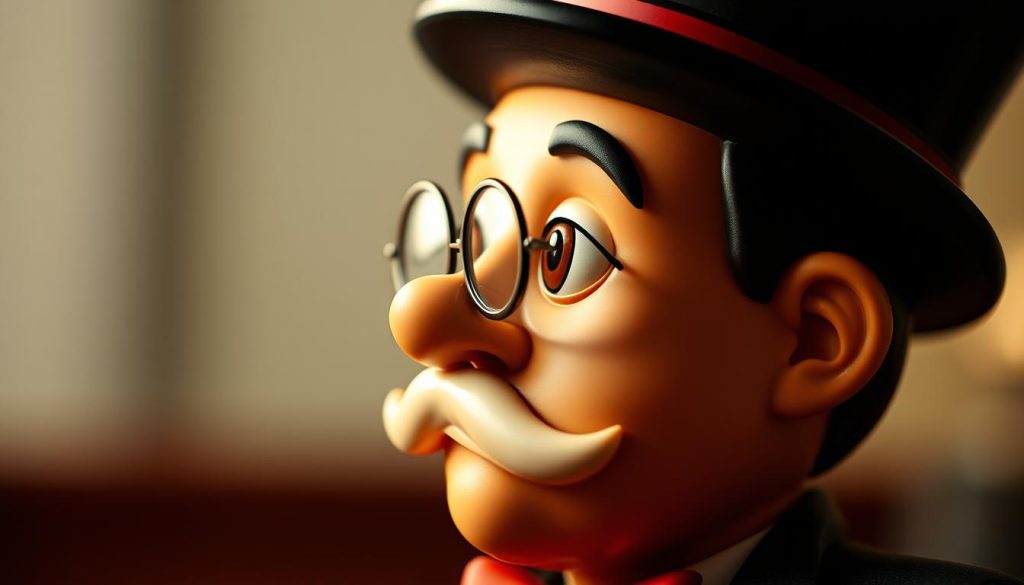The Mr. Monopoly monocle memory has become a fascinating cultural phenomenon. Millions of players remember the classic board game mascot differently than his actual appearance1. Many believe Mr. Monopoly once wore a monocle, but this is a collective misremembering2.
The confusion about this iconic character’s appearance has gained widespread attention. About 30-40% of people incorrectly recall Mr. Monopoly sporting an eyeglass1. This mix-up might come from visual similarities with characters like Mr. Peanut1.
A 2022 study in Psychological Science looked into this phenomenon. It tested people’s memories of mascots linked to the Mandela Effect. The research showed people confidently remembered Mr. Monopoly wearing a monocle2. However, there’s no historical proof to back this claim.
Online talks have made this memory quirk even more popular. A post about Mr. Monopoly’s supposed monocle got lots of attention2. It sparked about 57 comments and 100 quote-posts, with many surprised by the character’s true look.
Key Takeaways
- Mr. Monopoly never officially wore a monocle in standard game editions
- 30-40% of people incorrectly remember the character wearing an eyeglass
- The misconception is a prime example of the Mandela Effect
- Online platforms have extensively discussed this memory phenomenon
- Scientific research confirms the prevalence of collective false memories
The History and Evolution of Mr. Monopoly
Mr. Monopoly’s journey through vintage toys and classic games is fascinating. He first appeared on Monopoly cards in 1936. This beloved game piece has captivated players for decades3.
The character was unnamed until 1946 when he starred in “Rich Uncle”. He was known as Rich Uncle Pennybags. Mr. Monopoly’s design has changed over time, reflecting classic game piece evolution3.
Origins and Early Design
Mr. Monopoly started as a subtle yet distinctive character. From 1985 to 2008, he appeared in the Monopoly logo’s second “O”. In 1999, he was officially renamed Mr. Monopoly3.
Character Significance
Mr. Monopoly’s popularity earned him a spot among fictional rich characters. He ranked sixth on Forbes Fictional 15 list in 2006. By 2011, he had moved to ninth place3.
Design Evolution
- Early appearances on game cards
- Integration into Monopoly logo
- Official naming in 1999
- Continued representation in popular culture
A study revealed interesting facts about people’s perception of Mr. Monopoly. About 25% of participants unfamiliar with the logo drew him with a monocle4.
This detail shows how memory and visual recognition work in vintage toys. It highlights the complex nature of remembering classic game characters.
“Memory is not a perfect recording, but a dynamic process of reconstruction.” – Research in Cognitive Psychology
Mr. Monopoly Monocle Memory: Examining the Mandela Effect
Visual recognition often tricks our minds, creating fascinating phenomena like the Mandela Effect. This psychological quirk shows how collective memory can stray from reality. It’s especially common in popular culture memory misconceptions.
Popular Culture Misconceptions
Mr. Monopoly’s alleged monocle is a prime example. Surprisingly, 90% of people wrongly remember this iconic character wearing one. Yet, it was never part of his original design5.
This false memory has become a classic challenge to our perception6. It tests how well we recall visual details of familiar characters.
Social Media and Online Discussions
Online platforms have boosted this collective misremembering. Users share false memories, creating echo chambers that reinforce these mistakes. University of Chicago researchers found an interesting trend.
Participants confidently recalled incorrect features of characters they’d never truly seen7. This shows how easily our memories can be influenced.
Psychology Behind Collective Misremembering
The brain’s memory construction process can be surprisingly unreliable. Researchers found that individuals tend to:
- Spontaneously produce similar memory errors
- Fill in missing information with associated memories
- Confidently believe in false recollections
These memory distortions challenge our understanding of perception. About 75% of adults report experiencing at least one false memory in their lifetime5.
The Mr. Monopoly monocle memory is just one example. It shows how our minds can create convincing but false memories.
Conclusion
The Mr. Monopoly monocle memory reveals fascinating insights into our minds. About 50% of people believe the classic board game character wears a monocle. However, historical evidence proves this isn’t true8.
This odd phenomenon shows how complex human memory and perception can be. It’s especially true when it comes to classic games and pop culture9.
Board game nostalgia shapes our collective memories in powerful ways. The Mandela Effect shows how shared experiences can create false memories. These memories often stick around for generations10.
Our brains always rebuild memories, influenced by various factors. Social interactions, media, and personal views all play a role. This can lead to widespread misremembering9.
These memory quirks teach us to view our recollections with a critical eye. The Mr. Monopoly monocle myth sparks a wider discussion. It makes us think about how we see and remember cultural icons.
By exploring these discoveries, we gain new appreciation for human memory. We can marvel at its complexity while enjoying our shared experiences8.
FAQ
Did Mr. Monopoly actually wear a monocle?
Who is Mr. Monopoly originally?
Why do so many people remember Mr. Monopoly wearing a monocle?
When was the Monopoly game first created?
How has Mr. Monopoly’s design changed over time?
What is the Mandela Effect?
Can I find vintage Monopoly game pieces with different Mr. Monopoly designs?
Source Links
- 55 Mandela Effect Examples That’ll Make You Question Everything – https://www.goodhousekeeping.com/life/entertainment/g28438966/mandela-effect-examples/
- Mr. Monopoly Never Wore a Monocle? – https://www.snopes.com/fact-check/monopoly-monocle-uncle-pennybags/
- Mr. Monopoly – https://en.wikipedia.org/wiki/Mr._Monopoly
- The Psychology Behind the Mandela Effect – https://www.psychologytoday.com/intl/blog/unserious-psychology/202312/the-psychology-behind-the-mandela-effect
- 10 examples of the Mandela effect from ‘Jiffy’ to ‘Shazaam’ and why false memories are so common – https://www.businessinsider.com/guides/health/mental-health/mandela-effect-examples
- 15 Examples of the Mandela Effect – https://www.mentalfloss.com/article/585887/mandela-effect-examples
- Can you pick out the correct version of these famous pop culture icons? – https://news.uchicago.edu/story/visual-mandela-effect-false-memories-psychology-neuroscience-pikachu-mr-monopoly-waldo
- Top 8 Mandela Effects: When Memories Deceive Us – https://midmiccrisis.com/top-8-mandela-effects-when-memories-deceive-us/
- The Mandela Effect: A Curious Phenomenon of Collective False Memories – https://www.linkedin.com/pulse/mandela-effect-curious-phenomenon-collective-false-memories-ghiya-sau5f
- The Monopoly Man Has NO Monocle – It’s The Mandela Effect – https://www.monopolyland.com/monopoly-man-monocle/
